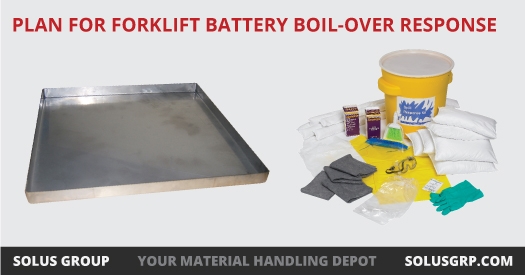We use cookies to make your experience better. To comply with the new e-Privacy directive, we need to ask for your consent to set the cookies. Learn more.
Plan for Forklift Battery Boil-over Response
Even in well-run battery rooms, there's occasionally a forklift battery boil-over.
The trouble is, water evaporates from electrolyte during use. You have to add water to battery cells to keep the plates submerged. But when staff accidentally add too much water to a battery, you might end up with a boil-over.
During certain points in the charging process, bubbling gas drives acid out of the plates, making the electrolyte level rise. Sometimes, they rise so high that the electrolyte spills out of the cells. Boil-overs aren't the safest events; sulfuric acid can leak, spray, or even explode out of a battery.
This situation is dangerous and costly for a number of reasons. First, there is a major safety concern. Sulphuric acid is caustic and can seriously injure workers. Secondly, spilled electrolyte can damage battery cases, charger stands, the battery room floor, and anything else it touches.
Products that absorb and neutralize acid on contact help eliminate danger quickly.
When a boil-over occurs, there are a few steps to take immediately to reduce the chances for injury and damaged equipment. Unfortunately, the very act of a boil-over can permanently reduce the battery's capacity by about 3 percent, reports Material Handling & Logistics.
You can never get that lost capacity back, but you can keep the damage to a minimum. Properly sized drip pans underneath all charging stands protect flooring. These heavy-duty trays collect the majority of spilled acid, allowing you to safely dispose of it.
Staff should use an OSHA-compliant spill kit to neutralize any caustic liquids that may have missed the drip pan. Quickly addressing spills will prevent pitting in battery room floors and keep staff from stepping in dangerous acid.
Staff should next address the battery case itself. For small amounts of residue, cleaning the battery case by hand can prevent further damage. For more extensive spills, thoroughly washing the battery in a cabinet is preferable.

Eliminating boil-overs altogether is the goal.
Boil-overs are not a necessary part of battery charging. The first step toward avoiding them is knowing how to add water to a battery. Always add water after a battery has charged (assuming the plates are covered by at least some electrolyte). Once the battery is fully charged, staff can add more water without risking a boil-over.
Using dedicated equipment to add water will ensure that electrolyte levels aren't dangerously high. This doesn't necessarily require investing in an expensive watering system. By using a reliable watering gun with automatic shutoff, battery-room operators can be sure that electrolyte is filled precisely to the appropriate level.
Aim for zero boil-overs, but have a response plan anyway.
Boil-overs reduce a battery's capacity, damage equipment, and can be dangerous to staff. They also take up valuable time as staff work to clean up spills and limit the damage. There's no question that battery-room managers should strive to avoid boil-overs. However, every operation should have a response plan to limit the damage in case the unexpected occurs.
A good response plan should include what protective gear to wear, where battery spill kits are kept, and what steps take priority. Quickly neutralizing spills from boil-overs protects batteries, floors, drip pans, charger stands, and staff. Keep your battery room and staff safe by having an appropriate spill kit and a response plan in the event of a boil-over.
Witt, Clyde. "All Juiced Up." MHLNews. Penton, 1 Jun. 2006. Web. 14 Sept. 2017.
